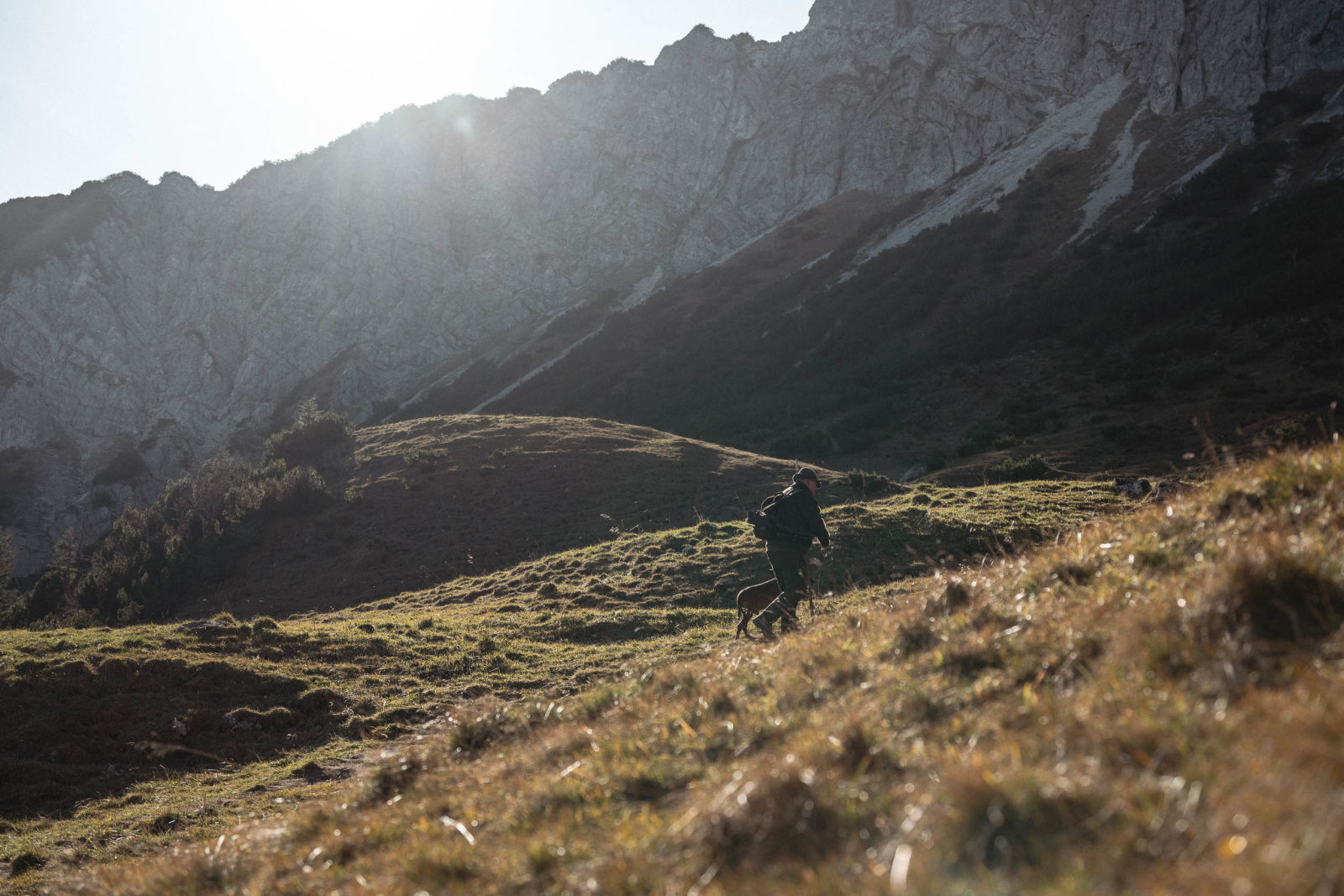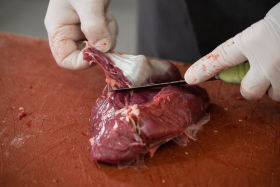Karl Schmid is a master butcher and hunter. These two areas are essential parts of his life, and mutually dependent.
Beside the Kochelsee lake in Bavaria, he has set up an EU-certified game processing shop next to his butcher’s store. “My guiding principle was and remains that I will only process regional game of the very highest quality.” In this article, he explains the key criteria for successful harvesting and preparation of game.
GAME IS IN TUNE WITH THE TIMES
Sustainable, healthy food has long been one of the most highly debated topics of our time. While some people only know meat as a neatly packaged product in supermarkets, others are deliberately opting for a plant-based diet. At the same time, the “slow food” movement is also gaining ground with locally produced, seasonal, and natural produce.
Hunting sits at the center of this divide. The animals live stress-free and die stress-free – if everything is done correctly.
Photocredit: Mario Ensmann

GAME IS A VALUABLE FOOD
Game is the “cleanest” type of meat. The animals eat only what is provided by nature. This means the meat contains no traces of medication and is practically cholesterol-free. The flavor is incomparable to even the most expensive Kobe beef.
But this premium food needs to be prepared with painstaking care.


1. Take a carefully considered and clean shot
2. Use the right equipment
3. Quickly deliver and dress or air the animal
4. Dress the game correctly and cleanly
5. Cut up the game correctly

PLANNING
BEFORE THE HUNT
“This actually starts before you even leave home,” says Karl Schmid, who has made a career out of passing on his knowledge in preparing game. “Before I go hunting, I think carefully about where I’m going, because after shooting an animal, I need to take it to the game collection center within 30 minutes so I can dress it in clean conditions.”

IT IS
ALL ABOUT THE TIMING
This time period is crucial to stop bacteria finding their way into the animal’s digestive tract and affecting the meat. However, logistical constraints mean it is often not possible to recover and refrigerate a harvested animal within this brief window, for example, when it is shot in rough and sparsely populated terrain. In such cases, Karl Schmid’s advice is to immediately air the animal: “Many people think it’s enough to make an incision below the front shoulders. But you actually need to open the animal’s abdominal cavity, starting at the pelvis, with an incision around ten centimeters (four inches) long – without damaging the bowel of course. This allows gases to escape.” This will also stop any dirt from penetrating during transportation, as the protruding internal organs will quickly seal this opening.
NO GOOD GAME WITHOUT THE RIGHT EQUIPMENT
But first, you need to harvest the animal. Exceptional optics are therefore essential: high-quality binoculars to select the right animal, and an excellent rifle scope to ensure a clean shot.

PRECISION
VENTRICULAR SHOT
This is crucial: “There is just one ideal shot to ensure good game meat and that’s the shot directly to the vitals, through the lungs and if possible, the heart.” Karl Schmid places particular emphasis on this as it is essential to allow the animal to bleed out properly. The blood gathers in the chest cavity and then immediately flows out.
IS THERE A PERFECT SHOT TO PRESERVE THE MEAT?
“People still talk about this myth of a perfect shot in the head or neck. But these are not actually perfect shots, as the major blood vessels remain intact. The animal does not then bleed out, which affects the quality of the meat.” In some countries, if a hunter makes this type of shot, they are required to immediately approach the animal and make a deep incision at the base of its neck with a knife to sever the carotid artery and allow the animal to bleed out.
AFTER THE HUNT
The animal is then completely broken down at the game processing area. The pelvis remains closed to prevent the hindquarters from drying out at the exposed areas. The organs are then examined for any signs of disease. If anything is identified, the animal must be disposed of.
If everything looks fine, the game is refrigerated and slowly cooled to 4° Celsius (39° Fahrenheit). This phase is called first aging and takes around 24 hours. Rigor mortis also sets in during this period. If this first aging is accelerated by excessively low temperatures, the cold will make the muscle fibers contract and the meat will be tough.

TIME AND TEMPERATURE
ALLOW THE GAME TO AGE CORRECTLY
After the first aging of the meat, the actual aging process starts. This takes several days, it’s best to leave the game in its skin or hide to stop the meat from drying out during this time. It is also important to make sure that the temperature does not rise above 4° Celsius (39° Fahrenheit) or fall below 1° Celsius (34° Fahrenheit), otherwise aging will not take place.
“Something many people don’t know: you can eat game even without a long aging time,” explains Karl Schmid. “This is called zero aging. If I cut up and consume an animal within the first 24 hours, it is beautifully tender. Imagine a yearling or roe deer under two years of age in May, reared on the best fresh herbs, prepared in this “zero aging” process: the taste is amazing.”

HYGIENE
SKINNING THE GAME
After aging, the next step is skinning, i.e. removing the skin from the animal. “Avoid any hairs from coming into contact with the meat as far as possible, as these will then be hard to remove.” Master butcher Schmid emphasizes another important point: “Always wear gloves, this is essential for hygiene reasons. And please: do not cut into the meat!”
To skin a deer, you need to make just four incisions with the knife: two on the inner hindquarters toward the pelvis and two around the sides of the flanks. Schmid uses the butt of his knife for the rest of the process, to remove the skin from the meat without cutting it.

SECRET TIP
BEAVER KNIFE
For larger animals or for wild boar with thick hides that are extremely difficult to remove and need to be cut away from the carcass piece by piece, he recommends a special knife that is not commonly known in Europe: “This is a knife with a rounded tip that looks a bit like a large butter knife. In the US, they call this tool a ‘beaver knife,’ and it’s ideal as the rounded tip completely avoids the risk of cutting into the meat. This means I am also able to use the flanks of wild boar or venison. I make a small incision and then use the handle to work the skin away from the carcass.”
THE TECHNIQUE – CUTTING CORRECTLY
The next step on the journey to the kitchen is cutting up the game: the hindquarters are removed from the pelvis, the front shoulders are separated from the carcass, and the backstraps from the neck and ribs. This is done while the animal is still hanging in the processing area, and the pieces are placed on clean plastic boards.
“This is followed by fine processing.” This topic makes Karl Schmid sigh a little: “You can follow the individual cuts of meat quite well. For example, the haunch and the shoulders are clearly separated by tendons and fine skin and almost packaged in individual parcels.
But it is best to have an expert show you how it’s done and then cut a few pieces yourself under supervision.” Schmid offers courses in this area, and also teaches the so-called “Swiss cut” whereby the game is cut up completely without tendons and fascia.
“Picture it like this: if I cut up a leg of venison the traditional way, I have the topside, outside round, flank, and haunch. Four pieces. The Swiss cut gives me twelve individual pieces that are ideal for pan-frying or barbecuing.”

BE CREATIVE
CUTLETS, GOULASH, AND MUCH MORE
Game doesn’t necessarily need to take the form of cutlets from the haunch, a loin fillet or goulash from the neck or shoulder. All the offcuts and bones can be boiled up to make a wonderful game consommé. Wild boar neck is ideal for an air-dried coppa, and venison haunch makes a delicious bresaola. The jowl of a wild boar can be used to prepare the famous Italian “guanciale” ham, the essential ingredient in pasta carbonara.
The neck or shoulder can be minced in a grinder. It won’t absorb water in the pan, and the taste beats beef or pork hands down. And if you don’t have a grinder, sausages are another possibility.
USING EVERY PART OF THE ANIMAL
Organs can also be used to make delicious game dishes. Most people are familiar with lung, liver and kidney, but not many know that you can cure venison or roe deer tongue to make tongue in aspic.
Of course, all this means work. But we are dealing with the highest quality food you can find in our part of the world, and it deserves this level of care and respect.
Clean gutting and field dressing are important to allow you to process the game neatly and precisely into the right parts. This means you will have good meat, piece by piece.

FROM SHOT TO POT
ABOUT KARL SCHMID
Karl Schmid is a dedicated master butcher and hunter from Upper Bavaria. Responsible handling of animals as a high-quality food source is a key priority for him. This also applies to his EU-certified game processing center. During his seminars, he shows participants how to process and refine every part of the animal – from nose to tail.



























